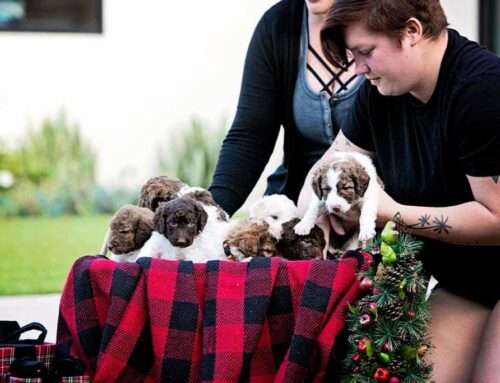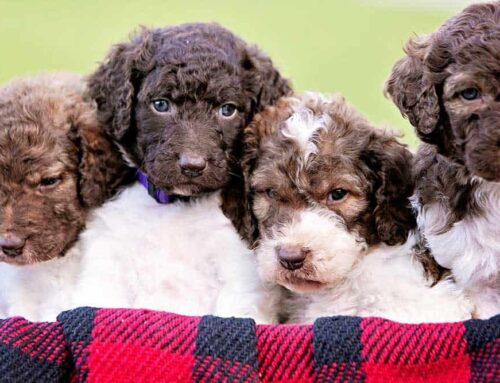Goldendoodles’ tear stains, often known as “tear markings” or “eye stains,” are the discoloration & remnant left behind by your dog’s normal eye discharge. Tear stains commonly form on the insides of your Goldendoodles’ eyes, and around its mouth and private areas, as a brown or reddish stain. In this comprehensive guide let’s dive into the reasons and ways to get rid of tear stains on Goldendoodle.
Porphyrins, a naturally occurring substance that your Goldendoodle excretes through saliva, tears, urine, and waste, are responsible for the crimson hue. An ordinary tear mark is typically red. However, chestnut brown staining may suggest a yeast infection caused by persistent dampness and germs.
What Causes Tear Stains
Getting rid of tear stains often involves addressing the underlying causes. Below are the reasons that cause tear stains.
Porphyrins, which are iron-containing compounds formed as the body breaks down red blood cells, are the most common cause of red tear stains. Porphyrin is excreted in enormous amounts by dogs through tears, spit, and urine. As a result, crimson colors might appear when porphyrin-rich saliva or tears sit upon light-colored dog hair for an extended period. Porphyrins are frequently to blame for red teardrop stains and beard stains in canines who drool and paw blemishes in dogs that lick their paws a lot. Porphyrin darkens in the presence of sunlight, making the stains more apparent and uglier.
Excessive Tearing
Excessive tearing is not normal, even if a small amount of eye gunk is present daily. Excessive tearing is characterized by constant wetness under the dog’s eyes and red or brown hair discoloration, also known as tear stains. Teething Goldendoodles may spit out a lot more tears. When the dog reaches adulthood, tear output and staining should decrease.
Tear Stains: Red vs. Brown (Yeast Infections)
Porphyrins are the most common cause of red tear stains, as previously stated. However, if the hair beneath your Doodle’s eyes is always damp from excessive tear secretion, he may develop a yeast infection. Yeast infections are marked by brownish discoloration rather than redness and an unpleasant odor. If your Doodle has a brown-colored fungal infection, it is most likely because his face is not cleaned or clipped. Fortunately, this is frequently a medical problem that may be addressed effectively by regularly grooming your Goldendoodle dog. Supplements aimed at reducing porphyrin-caused tear stains would not work in all dogs since brown staining from fungal infections & red stains from porphyrins is two distinct problems.
Infections caused by bacteria

The fact that porphyrin-decreasing supplements do not work in all dogs suggests that yeast infection is not the only cause of tear stains. It has been discovered that giving antibiotics to some dogs will stop them from producing too much porphyrin, implying that persistent low-grade pathogenic bacteria can also induce tear stains.
Tylosin, the antibacterial in the famous (and contentious) commercial medication Angels’ Eyes*, is typically helpful in bacterial infections. Doxycycline, metronidazole, and enrofloxacin are examples of antibiotics. These have been successfully used to treat tear stains.
Antibiotics are ineffective when it comes to yeast. Furthermore, while antibiotics are safe in small dosages, various dogs may react differently.
Antibiotics as a Last-Resort Treatment for Tear Stains
Antibiotic misuse has been linked to bacterial resistance. Thus, we should only use them as a last resort. “Tear stains aren’t severe enough to warrant giving your pet antibiotics.” After the FDA issued warnings against items like Angels’ Eyes and Angels’ Glow years ago, the school issued statements.
Several other states, including the United Kingdom and the entire European Union, have banned tylosin & tylosin-containing products. This is all to say: Only take antibiotics under your veterinarian’s supervision, and only if the tear discoloration tear production persists despite your best attempts to groom & keep your dog’s face porphyrin-free.
How to Prevent and Treat Tear Stains
As previously stated, the aim is to keep the area porphyrin-free.
Most tear stains may be avoided by keeping the face clean and groomed.
Here are a few suggestions for dealing with some of the root factors of tear stains:
- Keep the hair around Doodle’s eyes trimmed.
- Wipe the area with an eye grooming wipe or a gently damp washcloth at least once daily (or twice daily in Doodles with significant tear production), neutralizing and wiping away the porphyrin.
- Make an appointment with your groomer regularly.

- Plastic dog food bowls should not be used. Stainless steel, china, ceramic, or glass should be used instead. Plastic can acquire tiny cracks over time, allowing bacteria to enter and cause tear stains.
- If you reside in a harsh tap water region, give your dog bottled or filtered water (high in mineral and iron content).
- Provide your Goldendoodle dog best quality food. Porphyrin production can sometimes be reduced by eating a healthier diet. Most veterinarians would advocate giving a very well commercial brand of dog food. However, some owners swear by handmade or raw diets.
Conclusion
Tear stains are an unavoidable component of living for some Goldendoodles, so have no fear! There is a lot you can do to keep stains at bay. Please keep your Goldebdoodles’ eye stains at bay by cleaning & grooming them regularly. Also, consider switching your Doodle’s food to one free of cheap fillers. It will benefit his health in ways that are not just cosmetic.




